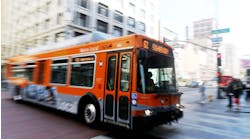Across the nation, analog, proprietary video surveillance systems are being replaced by unified open-architecture, IP-based systems as transit authorities consolidate the many disparate systems within their agencies, including onboard deployments for their fleets.
Rather than switching back and forth between many different systems to view and analyze data, modern unified systems allow transit organizations to bring various data sources together within a single interface, making it easier and faster to access and interpret information.
System unification provides greater operational insights
Unlike proprietary systems, open architecture unified video surveillance systems can bring together multiple systems and data sources, so transit authorities not only view video recordings, but also gain new insights by integrating this data with analytics such as occupancy, people-counting and more.
At the Massachusetts Bay Transportation Authority (MBTA), the promise of being able to gain insight across all systems in one place was so compelling that the organization decided to implement standardized open architecture systems within all buildings, train stations, bus stops and even on board its vehicles. In addition to upgrading its video surveillance system, the transit authority also added people-counting sensors, automatic license plate recognition cameras (ALPR) and more.
Now, when a bus is late because someone is illegally parking or driving in a dedicated bus lane, MBTA can use ALPR to capture the offender’s plate numbers from video captured by the onboard cameras. The system can also keep track of how often a particular car has been caught violating parking rules and, if they want to, use the plate information to issue a ticket. ALPR is also being used for park and ride, ticketing, counting parking spaces and more.
Evidence sharing through system unification
Because MBTA systems capture video evidence and other data that may be relevant for law enforcement, it has also adopted open-architecture evidence management software, which is unified within its video surveillance system dashboard.
When onboard cameras capture driving infractions, possible threats to passenger safety or other suspicious activity, the cloud-based software makes it easy to tag and share encrypted, watermarked video with the appropriate authorities. The software can blur faces to protect the privacy of bystanders if a decision is made to release video evidence to the public. It’s as easy as sending an email but ensures all best practices are followed to maintain a chain of evidence that will stand up in court if necessary. It also helps ensure security when sharing sensitive information among internal departments.
Being able to log in once and access information from video surveillance, ALPR, people-counting sensors, GPS trackers and more has made sharing data much easier than when using siloed systems. It can also significantly cut down on the workload to retrieve and share evidence with law enforcement.
Operational efficiencies gained through a unified system
A unified system can also introduce many other operational efficiencies. New technologies can be deployed more rapidly with an open architecture system, compared to a proprietary system. During the COVID-19 pandemic, for example, transit agencies were able to add people-counting sensors to their system to ensure that vehicles and buildings did not exceed the recommended capacity limits. Now that capacity limits are no longer in force, those sensors are being used to improve the accuracy of ridership counts. Having that data at hand helps the transit agencies validate ridership numbers, a vitally important metric for funding, as well as improve route planning and recommend service changes.
Considerations when adopting a new system
Before investing in a new system, it is important to do the research. A proprietary system can’t be unified with a non-proprietary system because unification requires open-architecture, ONVIF-compliant systems. ONVIF is a neutral industry standard that ensures systems created by different manufacturers can “talk” to each other. You can verify your system conforms to ONVIF standards online at onvif.org.
Cost is also an important consideration for many organizations that are interested in transitioning to a unified, open-architecture system, but it’s important to remember that the whole system doesn’t need an overhaul on day one. The upgrade can be worked toward gradually by choosing ONVIF-compliant systems for all new purchases.
Another option is switching to a unified, open-architecture system, whichcan offer significant long-term savings. Unifying all onboard and wayside systems within one software system may be cheaper than buying several different proprietary systems.
A unified system also makes it easier to streamline and automate certain processes and thereby saves resources. For example, at MBTA, retrieving and sharing video evidence previously required a lot more manual intervention. Someone had to physically remove hard drives from buses and trains, upload the data to another computer, copy the information to a disc or thumb drive, and walk or drive the file over to whoever else needed to see it. Now, the file is securely stored in the cloud and is easy to share via an encrypted link. The video surveillance software can also help find important moments caught on camera by cross-referencing with GPS and other data.
Moving to a unified system
Moving from siloed systems to a unified, open-architecture physical security system is a big undertaking, but your software partner should be ready and willing to support you every step of the way. Don’t be afraid to ask questions and get an in-depth tour of how the software works in transit applications. You want a partner who is excited to share insights gained from working with organizations like yours.
Exciting innovations are happening in technology that are helping transit authorities to improve rider and employee safety, operational efficiency and customer experience. Open architecture systems allow you to adopt best-of-breed technology as soon as it hits the market. You’ll be amazed what opportunities await when all systems work together within one unified platform.
-----------------
Shawn Enides is account executive, Transportation (U.S. and Canada) at Genetec.




